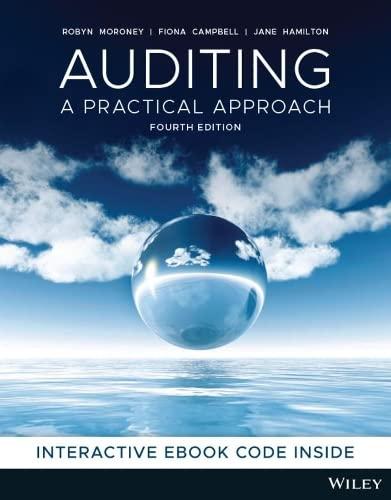In preparation to test other items on the income statement, Rory reminds Leigh to remember her introductory
Question:
In preparation to test other items on the income statement, Rory reminds Leigh to remember her introductory accounting. ‘An account balance is the result of the transactions that have been posted to that account’, he says. ‘Assets and liabilities are permanent accounts and revenues and expenses are temporary.’ This means that asset and liability balances reflect transactions over the life of the account, which could be many accounting periods. However, revenue and expense balances only reflect transactions for the current financial period because they are closed at the end of each year. The work you do auditing the balance of an asset and liability account in one year carries through to the next year. In some cases, an asset or liability balance does not even change during the current year; in this case, the auditor concentrates on substantiating the lack of change. In other cases, there are transactions to substantiate.’
‘The other distinguishing feature of most revenue and expense accounts compared to balance sheet accounts is that they have only one type of transaction posted to them. Some revenue and expense accounts, such as sales and purchases, contain many (perhaps millions) of transactions of the same type. The client usually has good controls over these repetitive transactions, and so we can increase our reliance on controls testing for this part of the audit.’
‘The good news’, he tells Leigh, ‘is that you can rely extensively on analytical procedures for revenues and expenses if the initial risk assessment suggests, and controls testing provides evidence to support, low inherent and control risk. We use tests of details to supplement the analytical procedures where the risk of material misstatement is higher.’
Revenue
The income statement doesn’t show the breakdown of Crest Outfitter’s revenue account, but discussions with staff and analysis of other internal accounting reports indicates that wholesale sales are approximately 45 per cent of total sales.
Leigh and Rory ask Ben for more information about how wholesale customers are managed. Ben provides them with the following information.
• There is no screening process for wholesale customers. They are allowed to purchase a maximum of $10 000 worth of stock in their first month. If this is repaid within the terms of 3/7 n/30, wholesale customers are permitted to place whatever orders they choose — there is no credit limit. ( 3/7 n/30 is shorthand for the credit terms offered — a 3 per cent discount is provided if the wholesale customer pays the invoice within 7 days; otherwise, the balance is due within 30 days from the date of the invoice).
• Wholesale orders are placed through a separate portal and the accounting transactions are manually recorded because Crest Outfitters has not yet integrated the wholesale order program with the company’s Xero accounting software. This is due to occur in the next 12 months.
Expenses
Leigh is not sure how to start identifying the most significant expense accounts. She is aware that the biggest risk with expenses is that they are understated on, or even omitted from, the trial balance. Rory reminds her that the audit team has already done the planning at the entity level. As a part of this process, the team has identified the key risks, processes and accounts.
‘For example’, he says, ‘we know that most of Crest’s manufacturing occurs overseas. This means that these transactions will occur using foreign currencies. How will this affect our audit procedures? Which assertion is at the greatest risk of material misstatement?’
Leigh knows that the controls testing Rory has completed has already produced some evidence about expenses. Rory suggests they use analytical procedures to focus on the key relationships between the expense accounts and various activity measures (such as employees) and other accounts (such as sales). As part of the controls testing procedures, the audit assistants have vouched expenses, such as purchasing inventory, to the underlying documentation. He recommends they perform more tests of details of inventory movements around year-end to gather evidence about cut-off and completeness of expenses. In addition, they will substantiate cash payments during the period following year-end to identify unrecorded liabilities and expenses. Tracing payments to the transaction file posting will help substantiate classification, particularly for items such as maintenance, which is often misclassified as an asset. He also recommends that they include specific procedures wherever there are additional disclosure requirements, such as related party transactions.
Required
(a) Tia has asked Rory to create an audit program for sales to wholesale customers. She has asked Leigh to focus on the assertions of accuracy, valuation and allocation. However, Tia reminds Leigh that she should still gather evidence on all procedures.
Remember that when designing audit procedures, you reference the appropriate audit procedure and include sufficient detail so that a fellow audit team member could follow your instructions. This may include instructions related to sampling and the population that the sample is chosen from.
(b) Design the audit program to test the cost of sales and foreign exchange gain/loss on the income statement. Remember that when designing audit procedures, you need to reference the appropriate audit procedure and include sufficient detail so that a fellow audit team member could follow your instructions. This may include instructions related to sampling and the population that you choose your sample from.
Step by Step Answer:

Auditing A Practical Approach
ISBN: 9780730382645
4th Edition
Authors: Robyn Moroney, Fiona Campbell, Jane Hamilton





